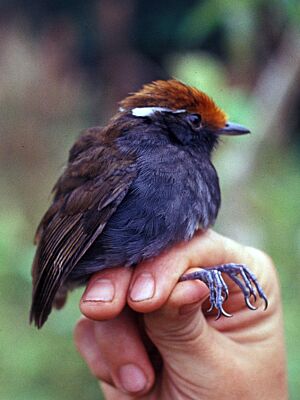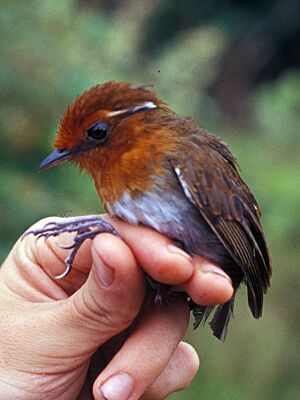Chestnut-crowned gnateater facts for kids
Quick facts for kids Chestnut-crowned gnateater |
|
|---|---|
 |
|
| Male (above) and female (below) | |
 |
|
| Conservation status | |
| Scientific classification | |
| Genus: |
Conopophaga
|
| Species: |
castaneiceps
|
| Subspecies | |
|
See text |
|
 |
|
The chestnut-crowned gnateater (Conopophaga castaneiceps) is a small, interesting bird. It belongs to the Conopophagidae family, which are known as gnateaters. You can find this bird living in the forests of Colombia, Ecuador, and Peru.
Contents
About This Bird
Scientists are still figuring out the exact family tree for the chestnut-crowned gnateater. Different groups, like the International Ornithological Committee (IOC), place it slightly differently within the gnateater family.
There are four main types, or subspecies, of the chestnut-crowned gnateater. Sometimes, birds found on the western side of Colombia's Central Andes might even be a new, unnamed type!
- C. c. chocoensis
- C. c. castaneiceps
- C. c. chapmani
- C. c. brunneinucha
What It Looks Like
The chestnut-crowned gnateater is about 13 to 14 centimeters (5 to 5.5 inches) long. It weighs around 27.6 grams (about 1 ounce).
The male of the most common type has brown upper parts. Its face, throat, and chest are gray. The sides of its body and the area under its tail are orange-brown. The top of its head is a bright orange-red. It also has a small white tuft of feathers right behind its eye.
Other types of this bird have slight differences:
- The C. c. chapmani subspecies has a brighter crown (top of the head).
- The C. c. brunneinucha subspecies only has orange-red on its forehead. It looks darker overall and has a white patch on its belly.
- The C. c. chocoensis subspecies is smaller. It has less gray color and a more olive-green tint on its back. It also has more orange-red on its crown.
The female chestnut-crowned gnateater looks a bit different from the male. Her head and chest are orange-red. Her belly is whitish. The white feather tuft behind her eye is smaller than the male's.
Where It Lives
The chestnut-crowned gnateater lives in different areas from central Colombia down to south-central Peru. It prefers to live in subtropical and tropical rainforests.
Here's where you can find the different types:
- C. c. chocoensis lives in Colombia. You can find it on the western side of the Western Andes mountains. It also lives in the Serranía del Baudó area of western Chocó Department.
- C. c. castaneiceps is found in Colombia's Central and Eastern Andes. Its range extends into Ecuador.
- C. c. chapmani lives on the eastern side of the Andes mountains. You can find it from southern Ecuador to the Department of San Martín in northern Peru.
- C. c. brunneinucha is found on the eastern side of the Peruvian Andes. Its range goes from Huánuco south to Cuzco.
This bird likes to stay inside the forest. It prefers areas with smaller plants, like places where trees have fallen or new plants are growing after a landslide. It usually lives at elevations between 1,000 and 2,000 meters (about 3,300 to 6,600 feet). Sometimes, it can be found as low as 500 to 600 meters (about 1,600 to 2,000 feet) in Colombia and Ecuador. In Peru, it has been seen as high as 2,200 meters (about 7,200 feet).
How It Behaves
What It Eats
The chestnut-crowned gnateater mostly eats arthropods. These are small creatures like insects and spiders. It looks for its food in the fallen leaves on the ground and in the plants close to the ground.
How It Breeds
Scientists don't know a lot about how the chestnut-crowned gnateater breeds. One nest was found in Colombia in February. It was a hidden cup-shaped nest, placed less than 1 meter (about 3 feet) above the ground. In Colombia's Central Andes, some birds were seen ready to breed between March and June.
Its Sounds
The song of the chestnut-crowned gnateater sounds like a series of frog-like notes. These notes speed up and get louder after the first one or two. Its calls include a harsh "zhiek!" sound and a lower "schek" sound.
Its Conservation Status
The IUCN (International Union for Conservation of Nature) has looked at the chestnut-crowned gnateater. They have assessed it as a species of "Least Concern." This means it is not currently considered to be in danger of disappearing.
While it might not be common in all parts of its home range, it does live in at least one protected area. This bird might even do well in areas that have been disturbed by humans. This is because dense, new plants often grow in these spots, which the bird seems to like.


